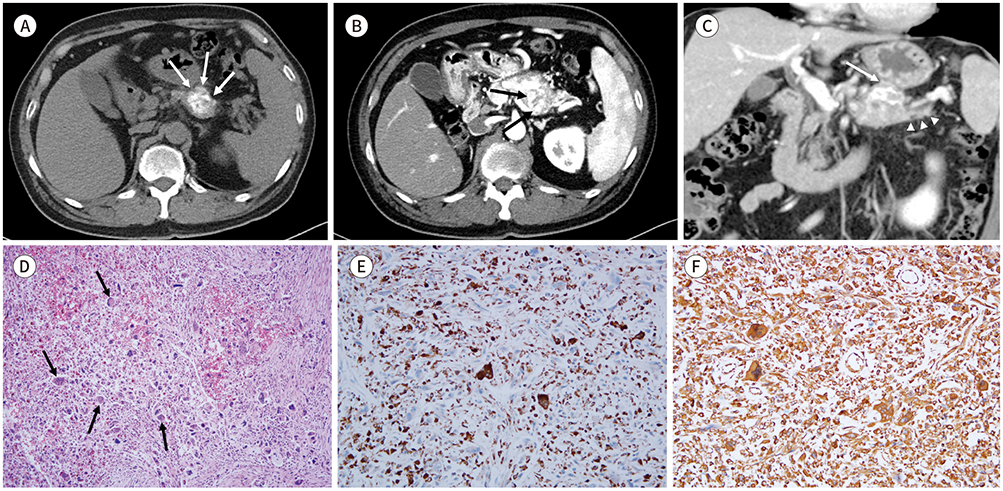J Korean Soc Radiol.
2019 May;80(3):585-590. 10.3348/jksr.2019.80.3.585.
Undifferentiated Carcinoma with Osteoclast-Like Giant Cells of the Pancreas Mimicking a Predominantly Calcified Mass: Case Report and Literature Review
- Affiliations
-
- 1Department of Radiology, Korea University Guro Hospital, Korea University College of Medicine, Seoul, Korea. jongmee.lee@gmail.com
- 2Department of Pathology, Korea University Guro Hospital, Korea University College of Medicine, Seoul, Korea.
- KMID: 2454040
- DOI: http://doi.org/10.3348/jksr.2019.80.3.585
Abstract
- Undifferentiated carcinoma with osteoclast-like giant cells (UCOGCs) of the pancreas is a rare neoplasm that contains osteoclast-like giant cells, which are morphologically identical to those seen in giant cell tumors of bones. Histopathologically, it is composed of round to spindle-shaped neoplastic cells and non-neoplastic histiocytic giant cells. Although only limited radiologic findings are available due to the rarity of this tumor, UCOGCs shows variable imaging features in the literature from an inhomogeneous solid mass to a multilocular cystic tumor. Herein, we report an unusual manifestation of UCOGCs of the pancreas mimicking a predominantly calcified mass with radiologic-pathologic correlation.
Figure
Reference
-
1. Rosai J. Carcinoma of pancreas simulating giant cell tumor of bone. Electron-microscopic evidence of its acinar cell origin. Cancer. 1968; 22:333–334.
Article2. Fukushima N, Hruban RH, Kato Y, Klimstra DS, Kloppel G, Shimizu M, et al. Ductal adenocarcinoma variants and mixed neoplasms of the pancreas. In : Bosman FT, Carneiro F, Hruban RH, Theise ND, editors. WHO classification of tumours of the digestive system. Lyon: IARC Press;2010. p. 292–295.3. Ichikawa T, Federle MP, Ohba S, Ohtomo K, Sugiyama A, Fujimoto H, et al. Atypical exocrine and endocrine pancreatic tumors (anaplastic, small cell, and giant cell types): CT and pathologic features in 14 patients. Abdom Imaging. 2000; 25:409–419.
Article4. Bauditz J, Rudolph B, Wermke W. Osteoclast-like giant cell tumors of the pancreas and liver. World J Gastroenterol. 2006; 12:7878–7883.
Article5. Shindoh N, Ozaki Y, Kyogoku S, Nakanishi A, Sumi Y, Katayama H. Osteoclast-type giant cell tumor of the pancreas: helical CT scans. AJR Am J Roentgenol. 1998; 170:653–654.
Article6. Muraki T, Reid MD, Basturk O, Jang KT, Bedolla G, Bagci P, et al. Undifferentiated carcinoma with osteoclastic giant cells of the pancreas: clinicopathologic analysis of 38 cases highlights a more protracted clinical course than currently appreciated. Am J Surg Pathol. 2016; 40:1203–1216.7. Gao HQ, Yang YM, Zhuang Y, Liu P. Locally advanced undifferentiated carcinoma with osteoclast-like giant cells of the pancreas. World J Gastroenterol. 2015; 21:694–698.
Article8. Molberg KH, Heffess C, Delgado R, Albores-Saavedra J. Undifferentiated carcinoma with osteoclast-like giant cells of the pancreas and periampullary region. Cancer. 1998; 82:1279–1287.
Article9. Joo YE, Heo T, Park CH, Lee WS, Kim HS, Kim JC, et al. A case of osteoclast-like giant cell tumor of the pancreas with ductal adenocarcinoma: histopathological, immunohistochemical, ultrastructural and molecular biological studies. J Korean Med Sci. 2005; 20:516–520.
Article10. Yang KY, Choi JI, Choi MH, Park MY, Rha SE, Byun JY, et al. Magnetic resonance imaging findings of undifferentiated carcinoma with osteoclast-like giant cells of pancreas. Clin Imaging. 2016; 40:148–151.
Article
- Full Text Links
- Actions
-
Cited
- CITED
-
- Close
- Share
- Similar articles
-
- A Case of Undifferentiated Carcinoma with Osteoclast-Like Giant Cells in the Pancreas
- A case of undifferentiated carcinoma with osteoclast-like giant cells of the pancreas
- Undifferentiated Gallbladder Carcinoma with Osteoclast-like Giant Cells: A Case Report
- Undifferentiated carcinoma of the pancreas with osteoclast-like giant cells
- Undifferentiated Pancreatic Carcinoma with Osteoclast-like Giant Cells: A Case Report


